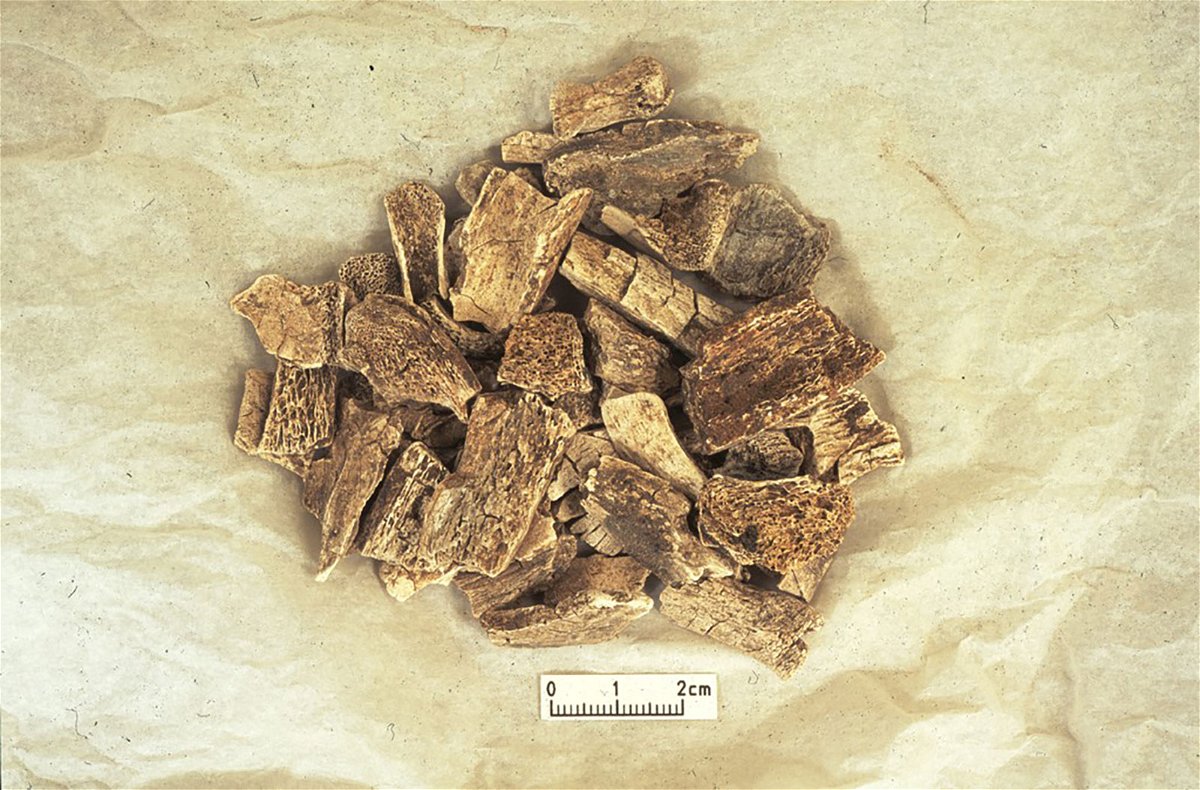Vikings brought their animals with them to Britain over 1,000 years ago

Cremated animal and human bones were found on the same pyre.
By Ashley Strickland, CNN
When the Vikings crossed the North Sea to reach Britain in the ninth century AD, they brought their dogs and horses with them, according to new research.
Archaeologists uncovered what they believe to be the first scientific evidence of this practice in Vikings while analyzing remains from a Viking cremation cemetery called Heath Wood in Derbyshire, England.
Heath Wood consists of 59 burial mounds, and 20 of them have been studied. Although the remains at the cemetery were cremated, bone fragments endure and serve as missing puzzle pieces, revealing information about who was there and when.
Researchers analyzed femur and cranium bones that were traced to two adults, one juvenile and three animals, including a horse, a dog and possibly a pig. Cremation was standard practice at the time for Scandinavians, while those in Britain buried their dead. But in order to determine the true origin of the people and animals at Heath Wood, the scientists took their analysis a step further.
The researchers tested the bone fragments for strontium, a natural element found in rocks, soil and water, which ends up in plants. When animals and humans eat plants, strontium makes its way into their bones and teeth. Strontium exists in different ratios around the world, acting like a geographical marker for the origins of various species.
One adult and one child cremated at Heath Wood were likely local to the area. But the bones of one adult, as well as the animals, had different strontium ratios that suggest they originated from the Baltic Shield area in Scandinavia, which included Norway and central and northern Sweden.
The adult and animals likely died soon after crossing the North Sea to arrive in Britain. The fact that they were included on the same cremation pyre suggests that the adult was someone of importance who brought their horse and dog with them — and the animals may have been sacrificed when the person died.
It’s possible that the pig bone was a preserved food source or token brought from home, rather than a living pig that was transported.
A study detailing the findings published Wednesday in the journal PLOS ONE.
New science and old viking stories
Previous work at Heath Wood used carbon dating to determine that cremation of the remains there occurred between the eighth and 10th centuries, but the origins of the cremated people and animals were unclear. The area is also of interest because the Viking Great Army wintered at Repton, which is near the cemetery, in 873 AD.
The army, which included warriors from different populations in Scandinavia and possibly the British Isles, invaded Britain in 865 AD.
The new findings offer distinct insights when compared with the primary source material used by researchers, the Anglo-Saxon Chronicle, an annual record of events compiled around 890 AD and written in Old English.
“Basically, it deepens our understanding of the Viking Great Army when it first arrived on British shores in East Anglia,” said lead study author Tessi Löffelmann, a doctoral researcher in Durham University’s department of archaeology and the department of chemistry at Vrije Universiteit Brussels.
“Our main primary source of the time, the Anglo-Saxon Chronicle, reports that the Army seized horses in Britain from the local population, but our isotopic evidence shows that this was not the only story — they also brought animals with them from their homelands.”
The voyage across the North Sea would have been “wet, cold, and uncomfortable for all parties involved,” as ships ferried animals and humans together, Löffelmann said.
The Vikings likely used a combination of their sleek long ships as well as larger ships with deep cargo space in their fleets crossing the North Sea. The Viking Great Army traveled by land and sea, with camps posted strategically at rivers where mounted warriors could get supplies from the slower moving fleet, according to the study.
The medieval Bayeux Tapestry, which famously depicts William of Normandy’s conquest of England in 1066, provides researchers with some idea of what this might have looked like. It is believed he brought 10,000 men and 2,000 to 3,000 horses across the English Channel.
“The Bayeux Tapestry depicts Norman cavalry disembarking horses from their fleet before the Battle of Hastings, but this is the first scientific demonstration that Viking warriors were transporting horses to England two hundred years earlier,” said study coauthor Julian Richards, professor in the University of York’s department of archaeology and codirector of the Heath Wood excavations, in a statement.
“It shows how much Viking leaders valued their personal horses and hounds that they brought them from Scandinavia, and that the animals were sacrificed to be buried with their owners.”
Animals played a key role in Norse mythology, including gods that could transform into animals, Löffelmann said.
“In the 9th century, Scandinavia was not yet Christian, and there was a strong oral tradition — only a few centuries later were these stories written down, but they tell us that animals had an important role to play in society,” Löffelmann said over email.
So it shouldn’t come as a surprise if the person buried at Heath Wood wanted to bring a prized hunting dog and personal mount, only to have the animals accompany them in death, she said.
The-CNN-Wire
™ & © 2023 Cable News Network, Inc., a Warner Bros. Discovery Company. All rights reserved.